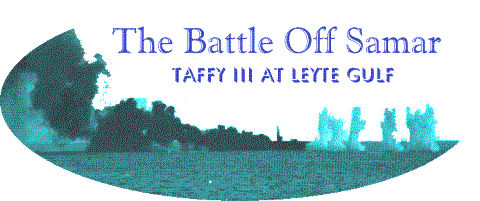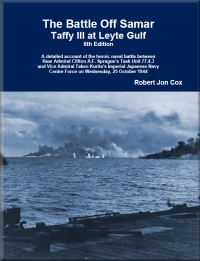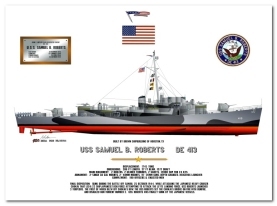
Flagship FANSHAW BAY and her three division mates - SAINT LO, WHITE PLAINS, and KALININ BAY - comprising Carrier Division 25, arrived on station near Leyte Gulf on 17 October 1944, Rear Admiral Clifton A.F. Sprague commanding. The CVE's were accompanied by DESPAC '44 veteran FLETCHER Class destroyers HOEL, HEERMANN, and JOHNSTON and BUTLER Class destroyer escorts SAMUEL B. ROBERTS and RAYMOND. Upon arrival they soon joined up with Rear Admiral Ralph A. Ofstie's Carrier Division 26, consisting of two escort carriers - KITKUN BAY and GAMBIER BAY. COMCARDIV 26 was screened by two BUTLER Class destroyer escorts - JOHN C. BUTLER and DENNIS. Upon the merging of the two carriers divisions, Rear Admiral Sprague became its overall commander and the unit was designated as Task Unit 77.4.3, radio call sign "Taffy 3".
The CVEs were known throughout the fleet as Combustible, Vulnerable, and Expendable, or "Kaiser coffins", named after their manufacturer, Henry J. Kaiser. Taffy III's CVEs were CASABLANCA Class escort carriers; 512 feet long, 108 feet of beam, displacing 7,800 tons. Their armament consisted of a single 5-inch gun on their fantail, eight twin 40mm and twenty 20mm anti-aircraft guns. Their biggest asset was their thirty aircraft. On average they carried 12 General Motors TBM Avenger torpedo bombers and 18 General Motors FM-2 Wildcat fighters.
Taffy III had three FLETCHER Class destroyers in its screen. Each destroyer had five 5-inch radar controlled guns and two 5-mount torpedo tubes. The four smaller destroyer escorts had two 5-inch guns apiece without radar control and only three torpedo tubes. The destroyers were ten knots faster than the destroyer escorts and they required 100 more men.





